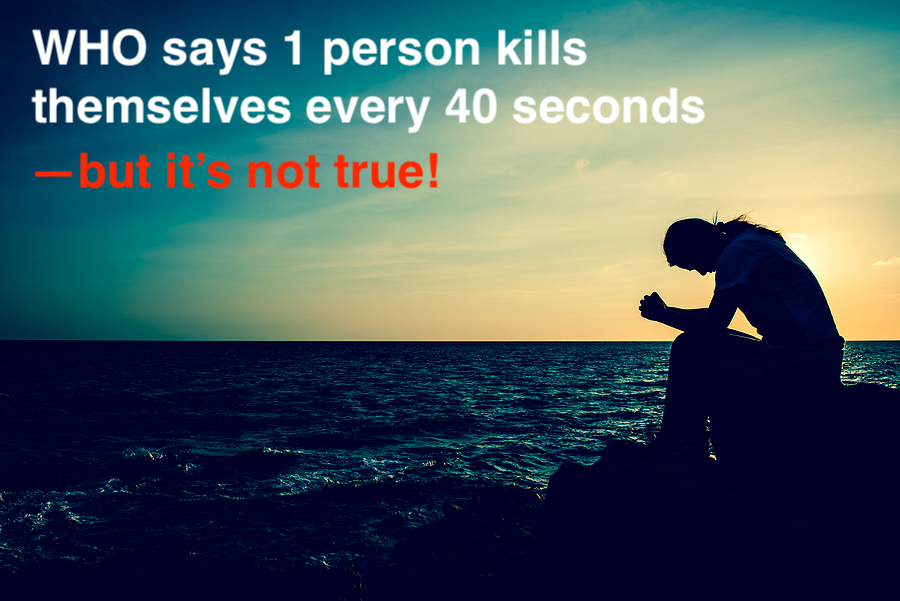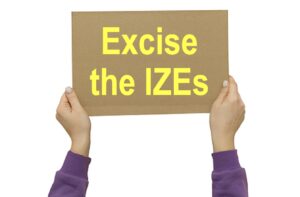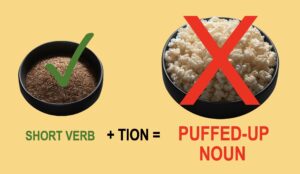
Quick tip: Don’t say “once every xx seconds…”
I’ve been researching suicide lately.
Don’t worry; I’m not thinking about doing myself in. It’s for a fictional story I’m working on.
In my research, I encountered a statistic that always bugs me. Here it is, from no less than the World Health Organization:
Suicide: one person dies every 40 seconds1
What a shocker, right?
Sounds like people are killing themselves on a steady drumbeat.
Coming up with a statistic like this is easy: Just divide the total number of seconds in a year (31,536,000) by the number of events in a year (in this case, 700,000+ suicides).
You can use that formula for anything: car accidents, sexual assaults, data breaches.
And people do, especially when they’re trying to raise awareness… and beat the bushes for donations.
But that’s just not accurate
Very few events in human society happen on a steady cadence.
In fact, suicides tend to peak at specific times of the week or year:
- Sunday night or Monday morning when people have to face another week2
- New Year’s Eve and Valentine’s Day when many feel lonely
- New moons and full moons, depending on the season3
So suicides simply don’t happen every so many seconds; they happen in clumps.

It’s the same with car accidents
More fatal car accidents happen Friday and Saturday nights.4
Accidents increase just after the clocks change5 for Daylight Savings Time, including more collisions with deer.6
Sexual assaults peak on weekends between midnight and 6 AM.7 And there’s usually lots of alcohol involved.
Cyber attacks are just the opposite: Most happen during business hours when sober employees click on tainted messages.8
So this “one every X seconds” statistic is just not accurate.
It’s a factoid designed to grab our attention and raise the profile of an issue in an alarmist way.
Why does this matter?
Sloppy use of statistics gives us a poor understanding of problems like suicide.
“Every 40 seconds” suggests some unseen menace can strike at ay moment. That reinforces a narrative of fear and helplessness.
When facing a dreadful problem, we need the very opposite: courage, hope, and empowerment.
If more people realized that suicides peak at certain times, we could take more effective countermeasures.
Perhaps on Monday mornings:
- Schools could give students time off for a talking circle
- Managers could schedule outings like team lunches, instead of on Fridays when most people are already happy
- Influencers could post positive messages, instead of “smug shots” that make other people feel worse
If we look beyond the “1 every 40 seconds” hype, we might discover effective tactics such as banning dangerous pesticides like paraquat (PQ).9 This approach has worked in several countries.
Plus, it delivers a wonderful side effect: less poison going into the food chain. (PQ has been linked to Parkinson’s disease.10)
Be part of the solution
I believe statistics are supposed to help us understand an issue, solve a problem, or make a decision. Just like a white paper.
So please be careful how you use stats in your B2B content.
To see more useful tips like this, get my free newsletter, White Paper World.
Sources
1: “Suicide: one person dies every 40 seconds,” World Health Organization, news release, 9 September 2019, retrieved from https://www.who.int/news/item/09-09-2019-suicide-one-person-dies-every-40-seconds
2: Nadia Whitehead, “Suicide Most Common on Two Days of the Week,” Science.org, 9 April 2014, retrieved from https://www.science.org/content/article/suicide-most-common-two-days-week
3: “Suicide ‘linked to’ the moon,” BBC, 6 July 2000, retrieved from http://news.bbc.co.uk/2/hi/health/820241.stm
4: “Overview: Crashes by Time of Day and Day of Week,” National Safety Council, 2021 statistics, retrieved from https://injuryfacts.nsc.org/motor-vehicle/overview/crashes-by-time-of-day-and-day-of-week/
5: Jane Ulitskaya, “Daylight Saving Time Dangers: Deadly Crashes Spike, Studies Show,” Cars.com, 10 retrieved from https://www.cars.com/articles/daylight-saving-time-dangers-deadly-crashes-spike-studies-show-463423/
6: Cunningham et al, “Permanent daylight saving time would reduce deer-vehicle collisions,” Current Biology 32, 4982–4988, 21 November 2022, retrieved from https://doi.org/10.1016/j.cub.2022.10.007
7: “Factors the increase sexual assault risk,” National Institute of Justice, U.S Department of Justice, 30 September 2008, retrieved from https://nij.ojp.gov/topics/articles/factors-increase-sexual-assault-risk
8: Fahmida Rashid, “Don’t like Mondays? Neither do attackers,” CSO.com, 25 August 2017, retrieved from https://www.csoonline.com/article/561961/don-t-like-mondays-neither-do-attackers.html
9: “Save Lives,” Centre for Pesticide Suicide Prevention, The University of Edinburgh, undated, retrieved from https://centrepsp.org/the-solution/
10: “Paraquat exposure induces Parkinsonism by altering lipid profile and evoking neuroinflammation in the midbrain,” Environment International, November 2022, retrieved from https://www.ncbi.nlm.nih.gov/



